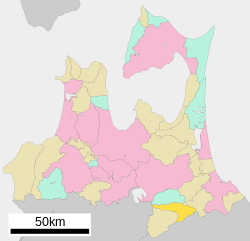|
Sannohe
 Sannohe (三戸町, Sannohe-machi) is a town located in Aomori Prefecture, Japan. As of 31 January 2023[update], the town had an estimated population of 9,146 in 4141 households,[1] and a population density of 60 persons per km2. The total area of the town is 151.79 square kilometres (58.61 sq mi).[2] GeographySannohe occupies an inland area in southeast corner of Aomori Prefecture, south of the Hakkōda Mountains. The terrain is relatively flat, with mountains extending in the northwestern part of the town. The Mabechi River flows from north to south through the center of the town. Neighbouring municipalitiesClimateThe town has a cold maritime climate characterized by cool short summers and long cold winters with heavy snowfall (Köppen climate classification Cfa). The average annual temperature in Sannohe is 10.2 °C. The average annual rainfall is 1259 mm with September as the wettest month. The temperatures are highest on average in August, at around 22.9 °C, and lowest in January, at around -2.5 °C.[3]
DemographicsPer Japanese census data,[6] the population of Sannohe peaked in the 1950s has steadily declined since. It is now less than it was a century ago.
HistoryThe area around Sannohe has been inhabited since ancient times, and numerous Jōmon period remains have been found. During the Kamakura period it was the center of the domains awarded to Nanbu Mitsuyuki, a retainer of Minamoto no Yoritomo after the defeat of the Northern Fujiwara clan in 1187. It remained under the control of the Nanbu clan through the Sengoku period as a castle town centered on Sannohe Castle. During the Edo period, came under the control of Morioka Domain, and a daikansho was established on the site of the former castle. It was proclaimed a town after Meiji Restoration, with the establishment of the modern municipalities system on 1 April 1889. On 20 March 1955, the three neighboring villages of Sarube, Tomesaki and Tonai merged with Sannohe. GovernmentSannohe has a mayor-council form of government with a directly elected mayor and a unicameral town council of 14 members. Sannohe is part of Sannohe District which contributes three members to the Aomori Prefectural Assembly. In terms of national politics, the city is part of Aomori 2nd district of the lower house of the Diet of Japan. EconomyThe economy of Sannohe is heavily dependent on agriculture, with tobacco as the main crop, followed by rice and apples. Due to its many historical relics, the town is also developing tourism as a mainstay of the local economy. EducationSannohe has two public elementary schools and one public middle schools operated by the town government and one public high school operated by the Aomori Prefectural Board of Education. TransportationRailway
HighwayInternational relations
Local attractions
Noted people from Sannohe
References
External linksWikimedia Commons has media related to Sannohe, Aomori.
|
|||||||||||||||||||||||||||||||||||||||||||||||||||||||||||||||||||||||||||||||||||||||||||||||||||||||||||||||||||||||||||||||||||||||||||||||||||||||||||||||||||||||||||||||||||||||||||||||||||||||||||||||||||||||||||||||||||||||||||||||||||||||||||||||||||||||||||||||||||||||





